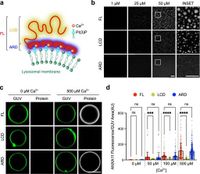Recent research uncovers the intricate relationship between protein and lipid phase transitions in cellular biology, suggesting co-regulation systems that could enhance our understanding of intracellular dynamics and disease mechanisms.
The study, published in the prestigious journal Cell Biology, explores how phase transitions of proteins and lipids not only coexist but can also influence each other’s states in cellular contexts. The research focuses on the role of the ANXA11 protein in tethering ribonucleoprotein (RNP) granules to lysosomal membranes, indicating that changes in the protein phase state can induce shifts in lipid phase as well.
The team of researchers identified two significant interacting proteins, ALG2 and CALC, which modulate the phase state of ANXA11 and thus regulate lipid dynamics in the lipid bilayer. This co-regulation may play an essential role in cellular processes such as RNA trafficking, highlighting the dynamic interplay between protein structures and membrane integrity.
Using experimental methods to simulate and observe the behavior of ANXA11, the researchers demonstrated that the low complexity domain of ANXA11 triggers phase transitions that can lead to a liquid-to-gel transformation in the lipid membranes associated with lysosomes. This transformation contributes to the stability and rigidity of the condensate structure, which is crucial for its functional interactions with RNP granules.
Induced changes in lipid order and protein organization suggest a potential mechanism by which these biomolecules communicate within cells. Importantly, the research holds promise for revealing processes at play in cell types with particularly demanding cellular architectures, such as neurons, where protein-lipid interactions are critical for maintaining equilibrium and facilitating transport.
The implications extend to understanding cellular responses and the potential impact these findings may have on diseases associated with aberrant lipid or protein behavior, like neurodegenerative disorders. As an example, ongoing research into ALS has pointed to the need for further exploration of ANXA11's pathogenic changes.
Overall, this study illuminates a vital yet understudied aspect of cell mechanics, providing a valuable template for future investigations into cellular organization and function.

